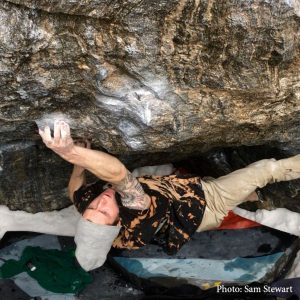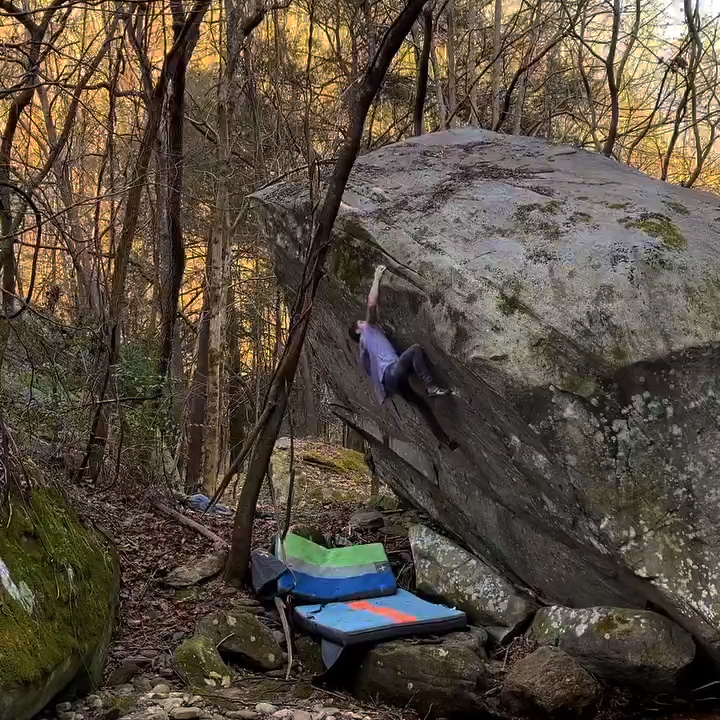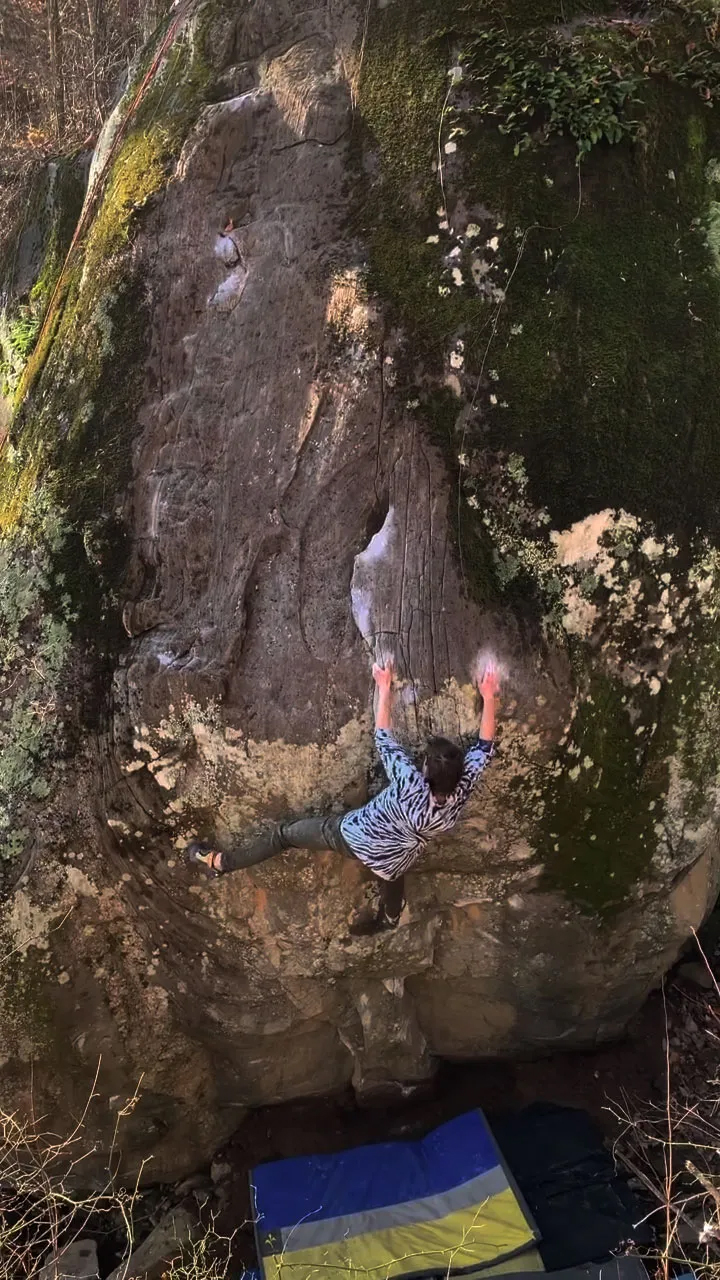
Since leaving a trail of hundreds of FAs in Colorado’s Front Range, including the epic, Purgatory V14 mega line in Poudre, Sam Rothstein has established himself as a powerhouse in the Southeast. From his first month in the Asheville area, Sam was establishing new lines in old haunts. He quickly found a V12 project in Rumbling Bald, put it together, and put his name on Geomorphic. He has also crushed many of the region’s V-Hard Classics. His long list includes Magnum V13, Under Undertow V13, both on Corner Rock, and The Shield V12 at LRC. Sam’s unwavering drive and boundless energy make him a true KinetiK Athlete. Check out his previous videos from his first winter in the Southeast.
Sam’s exploits in the Southeast have encompassed over 85 First Ascents since landing in Asheville in 2021. In this last winter alone, he has been tearing up the region with a hefty list of 35 new climbs over 9 areas. With the season winding down, we reached out to get an insight into this last season, and what Sam feels are the highlights and future of the area’s untapped potential. If you are curious about Sam’s thoughts on developing new climbs, keep reading to find out.
An Interview with Sam: This Southeast Season
What is your process of finding a new line?
Typically, with established areas, I will always be on the hunt for new lines. The process starts by getting eyes on all the boulders in the area. When I first started climbing at Rumbling Bald, after I was done climbing, I would go exploring to check out projects listed in the books and pour over every side of every block in the park. After I start seeing problems that could be interesting, I typically try to view the climb from all sides and imagine what the problem would look like with chalk and the landing in the best condition possible. This helps me get an idea of whether the climb would even be worth cleaning. If I decide a problem has potential to be interesting, I will start work on cleaning and preparing the landing.
After this step is complete, I typically step back and look again at the boulder to see if it is something I want to attach my name to. I’ve definitely cleaned a few and then later decided I would leave it alone because it wasn’t worth the effort for me personally. After doing enough first ascents, I no longer have the same drive when I started to establish every possible climb. Now I really try to cherry pick the most interesting ones that have a few things that call out to me. Usually it’s the difficulty, height, angle and quality of holds that draw me in to establish a line. Oftentimes after I clean the problem and begin trying, I realize that the problem is too hard to just send quickly and must decide whether I want to make the investment in terms of projecting.
Which individual line are you the proudest of establishing?
I found Pace Yourself V11, with Ryan Brazell, on a scouting day after I heard rumors about a few boulders lying beneath an old sport climbing crag, known as the Pace Cliffs. After an hour or two of bushwacking, we were ready to call it a day, but Ryan had spotted something on the Maps that looked potentially interesting. We debated for a few minutes whether or not it would be worth it to head down this steep gully and inspect, since it was raining and we were already tired. We figured we would head down the gully 100 yards to see if we could get our eyes on it, and it immediately became obvious. What we saw on the maps was a HUGE, 35 ft tall egg-shaped boulder. We ran down the gulley, and Ryan came up on the overhanging side. We were both blown away.
Sandstone like rock, super atypical for the area, obvious holds that went to the top of the overhang, and then an imposing slab that was completely covered in a blanket of moss. My first concern was that the entire problem would go, but the finishing slab would be too blank. After throwing the rope on, which took some creativity by tying rocks to the rope and throwing it over the boulder, I started pulling back some of the moss carpet and saw all sorts of indentations and holds. The problem would be possible. Returning the following weekend, I spent a few hours cleaning up the slab and the overhanging section then arranged as many logs as we could find in the landing to make the problem as safe as possible.
I started trying the line and was quickly working to the upper section of the overhang but couldn’t figure out a usable sequence for the top. I threw the rope back on and dialed in the upper section and cleaned an awful sloper that I thought was too bad to use, but it ended up being exactly what I needed to gain compression and build my feet to reach for the finishing jug. The reason I’m the most psyched on this ascent is because I went through the entire development process from finding the line, cleaning it, and working out the beta. It’s always more rewarding when you go through the process yourself instead of getting handed a first ascent on a silver platter by another climber which is a lot more often the case.
How do you piece together the movements after you choose a potential project?
Since I moved to NC two years ago, I really haven’t dived into any serious projects. I’ve mostly just been trying to see and climb as many quality problems as possible in the Asheville region. Typically, piecing together moves is my strong suit in terms of projecting. When I can get all the movements down, my muscle memory kicks in, and I can repeat the movements even when tired from attempting from the start. My biggest struggle has always been tackling those individual moves, where I try everything, and just can’t figure it out.
It can be hard to get motivated to try projects with moves that I wasn’t able to get close on in a previous session. Diving into a real project can also be very time consuming, mentally draining and is generally not as fun as doing climbs you know you can do in a few sessions. Although the trade off is that the real projects are infinitely more rewarding when the process gets completed. My focus next season will be a lot less exploring and a far fewer first ascents in return for a few big ticket items that I would really like to get.
Are you guided to “projects” in areas, or are you searching on your own for new, un-climbed rock?
It’s a big mix of both. Projects that others have tried in the past, and haven’t been done, gain a reputation since people talk about them, and they’re often in popular areas. Finishing off a longstanding project feels like King Arthur pulling Excalibur from the rock. A fun process to try and succeed where other strong climbers have failed. The biggest satisfaction for me is finding a totally new line that no one has attempted, it can be nice to have no sense of reference for grade or difficulty and just figure out the problem is even possible at all. Oftentimes a foothold in the right spot can be the difference between V-insane and V10 and it’s hard to figure out that until you start trying.
How do you see the development of new areas in the Southeast region going forward?
Development for new areas is mostly going to come from the hard work of local climbing coalitions coupled with climbers going out and searching so the Coalitions can get an understanding of where the good resources lie. State parks can be challenging to work with and have a reputation for saying no to bouldering in general. Hopefully, climbers can continue to foster strong relationships with land owners so at the very least we can maintain the bouldering we have and not lose any of the areas we love. Thankfully, there is so much rock randomly scattered around out here that as long as people continue looking, we will always have new areas to develop and share with the community.
Do you have any opinion on the climbing scene in the Southeast compared to the Front Range?
Climbing in the Southeast has two main drawbacks: the first is that there is not nearly as much public land as out west and the second is that the number of days with good weather for hard bouldering is limited. The other issue here, for Asheville specifically, is that the climbing is scattered randomly around so it can be tough to hit a lot of climbs in a day if you don’t go to Rumbling Bald. The benefit is that there is so much to discover and amazing boulders can be hidden literally anywhere around here.
The climbing community is a lot less competitive around Asheville. I feel the scene is up and coming since most people aren’t aware of how good it is out here. Colorado bouldering holds a very special place in my heart, but I don’t plan on moving back anytime soon. Which indicates how good it is around here.
Is there a new region or new area that you’ll be looking to next for projects? Any secret areas that we can’t talk about?
I definitely have a few local spots I’d like to look at that could have some real potential. Now, with the van converted, I’ll be looking to expand my horizons in the Southeast. I plan to climb and develop more throughout the entire region. No secret areas here! If I put information online, I’ll always share the pin when someone asks.
Thank you to Sam Rothstein for letting us know a little more about this last season in the Southeast. His hard work and dedication continue to inspire the whole KinetiK community and the climbing community as a whole. Follow his exploits on his Instagram Page, @sam_rockstein, and stay tuned for more updates on the KinetiK YouTube Page. Below is a sampling of Sam’s contributions to the community. It is just a small slice of all the lines he has found over the years.
Sam’s Southeast Climbing FA list (Sep 2022 – April 2023)
35 new problems, over 9 areas:
*Linked to Footage where applicable!!
Rumbling Bald:
Eagle Rock:
Youngs Mtn:
White Fang V11
Pace Cliffs:
Raven Rock:
Alluvium V10
Quarting Doom V9
Boogie Fever V9
The Creeper V5
Burnsville:
Moon Shadow V10
Quiet Spoon V9
Spooners V9
Looking Glass:
Jones Gap:
Red Feather Lakes CO:
Time Warp V11
Enforcer V10
Gift Wrapped V10



